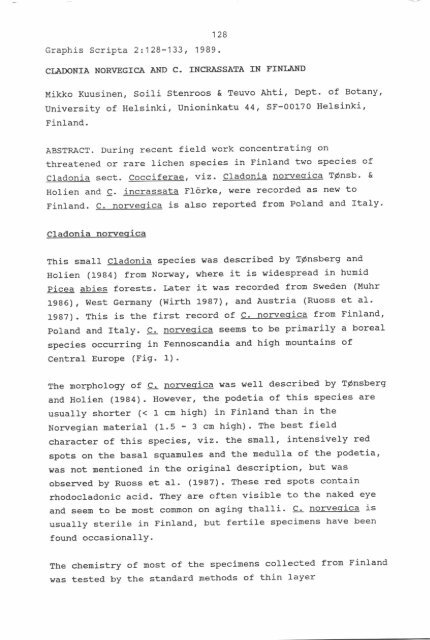Create successful ePaper yourself
Turn your PDF publications into a flip-book with our unique Google optimized e-Paper software.
Graphis Scripta 22128-133 , 1989.<br />
128<br />
CIADONIA NOR\IEGTCA A}ID C. INCRASSATA IN FINIAND<br />
Mikko Kuusinen, Soili Stenroos & Teuvo Ahti, Dept. of Botany,<br />
University of Helsinki, Unioninkatu 44 , SF-ool'? 0 HeIsinki,<br />
Finland.<br />
ABSTRACT. During recent field work concentrating on<br />
threatened or rare lichen species in Finland two species of<br />
Cladonia sect. Cocciferae , vLz. Cladonia no:rregica Tpnsb. &<br />
Holien and g. incrassata Plorke, were recorded as new to<br />
Finland. C. norrregica is also reported f rom Poland and ltaly '<br />
Cladoni-a norrregica<br />
This small Cladonia species was described by T/nsberg and<br />
Holien (1984) from Nor:vay, where it is widespread in hunid<br />
picea abies forests. L,ater it hras recorded f rom Sweden (l{uhr<br />
j.9g6) , West Gemany (wirth Lg87) , and Austria (Ruoss et aI-<br />
19g7) . This is the first record of C. notrrecrica from Finland,<br />
poland and f ta1y. g- nonregica seems to be prirnarily a boreal<br />
species occurring in Fennoscandia and high mountains of<br />
Central EuroPe (Fig. 1) -<br />
The morphology of e. norrrecrica nas well described by T/nsberg<br />
and Holien (1994). However, the podetia of this species are<br />
usually shorter (< 1 cm high) in Finland than in the<br />
Norrregian naterial ( 1. 5 - 3 cm high) . The best f ierd<br />
character of this species, vLz. the small, intensively red<br />
spots on the basal squamules and the medulla of the podetia,<br />
was not nentioned in the original description, but was<br />
obselrred by Ruoss et al . ( 1987 ) . These red spots contain<br />
rhodocladonic acid. They are often visible to the naked eye<br />
and seem to be most common on aging thalli. g. notrregica is<br />
usually sterile in Finland,, but fertile sPecimens have been<br />
found occasiona1lY.<br />
The chemist<strong>ry</strong> of rnost of the specimens collected from Finland<br />
was tested by the standard methods of thin layer

















